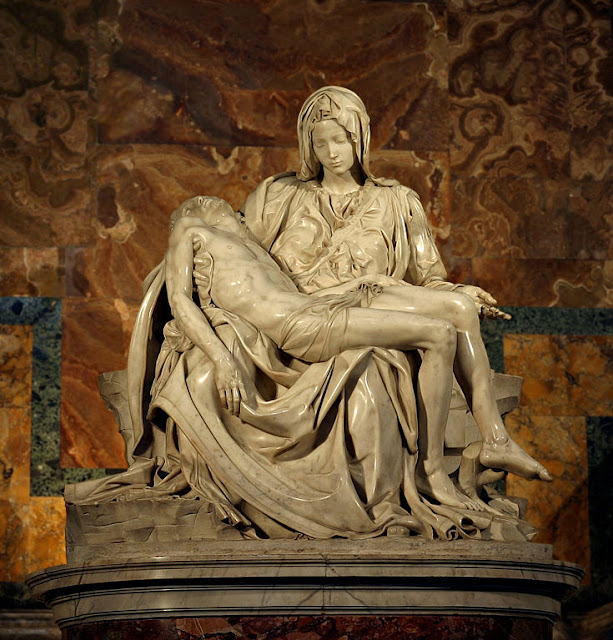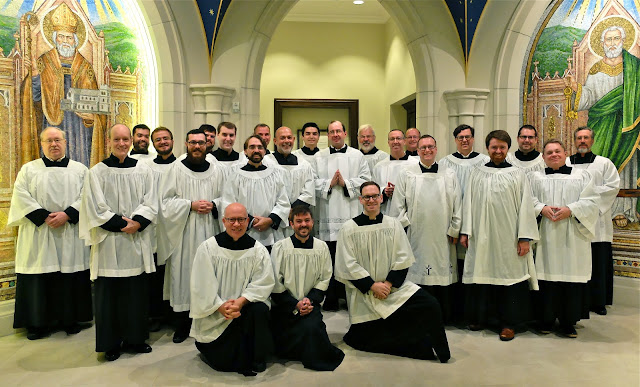Why Use Sacral English In Worship?
 |
| The Lesson |
[ Read time 8 minutes ]
Sacral EnglishFrom the OLSC Ordinariate, ed. by Gilbert.
- The Book of Common Prayer as written by Thomas Cranmer remains a literary masterpiece. It developed a beautiful poetic way of conversing with God in the vernacular at a time when the western Church spoke only Latin. Yet Cranmer’s English was never vulgar or banal.
- We continue this tradition in the Ordinariate in the language we use in our liturgies. Since the liturgy is an encounter with God, the language we use should be appropriate to this encounter. We know from our own personal experience that we speak differently for different situations. The way we speak to our friends at a BBQ is different to how we would speak if we were giving a speech at a wedding. Put simply – when we speak to God we do not use day-to-day language, we use sacred language.
- For this reason, the liturgies which have been approved for use in the Ordinariate are informed by the language of the Book of Common Prayer, either drawing directly from it, or using language in the style of it. We do this not for the sake of being old-fashioned, but as a reminder of the divine encounter we experience in the Liturgy.
Very Members Incorporate: Reflections on the Sacral Language of Divine Worship by Clinton Allen Brand
Liturgy, of its very nature, as the public worship of God and the recollected enactment of divine mysteries, requires a language set apart from everyday communication, description, and commerce. Historically liturgical language, even when it aims at intelligibility and engaged participation in the vernacular, is inevitably, to one degree or another, a specialized idiom (a Sondersprache), a register of language purposefully situated and one that takes its place as an integral component in the overall Gestalt of enacted praise, thanks giving, penitence, supplication, and sacramental participation. Liturgical language in the Catholic tradition is the verbal cognate of the stylized gestures, ritual actions, vestments, candlesticks, and architectural ordering of the sanctuary, themselves hearkening back to the historical character of ancient cultural forms and all of which work together with the dialect of proclaimed prayer to take the worshiping congregation out of the profane world into a sacred precinct for a dedicated and communal encounter with God. Accordingly, notes Crystal, liturgical language fulfills its proper function when it achieves qualities of dignity, stability, and memorability, and it typically, historically, has served these ends through the select retention of “archaisms, specialized vocabulary, and formulaic diction,” all to help transcend the inevitable flux and contingency of linguistic change and to shape an enduring idiom of public prayer.
- Crystal, “A Liturgical Language in a Linguistic Perspective,” 151–152.
- https://files.ecatholic.com/3059/documents/2016/3/2015_Brand_Antiphon.pdf?t=1457623388000
ibid., Brand
(I)nsofar as language itself is the storehouse of sustaining memory, one can say that the words of liturgical worship also serve to recollect and evoke the ambient linguistic and historical context in which that saving grace has been operative for pilgrim peoples throughout the ages, for those scattered at Babel but now gathered by the indwelling Spirit in the unity of the Church and in the unifying culture of “the Church’s own way of speaking” (ecclesiastica loquendi consuetudo). Accordingly, I would suggest that the achievement of Divine Worship can be understood as a special application of this principle of linguistic anamnesis for the healing of schism, for the honor of a purified medium that nourished aspirations to Catholic unity, and for the enfolding of a particular liturgical patrimony that itself enfolds and contains in layered resonance the memory of salvation history in its Hebrew, Greek, and Latin expressions, all mediated through an idiom of English going back to the beginnings of our tongue’s first sustained liturgical use in the sixteenth century. The language of Divine Worship, including its characteristic archaisms, specialized vocabulary, and formulaic diction, with their roots in the historic Books of Common Prayer, could be said, at least for a particular pastoral constituency of converts in their ecclesial pilgrimage, to model and participate in the typological and paschal pattern of exitus (going forth) and reditus (coming home) with all the salient marks of the journey preserved intact.
- Notes. Cf. Catechism of the Catholic Church, 2nd ed. (Washington, DC: United States Catholic Conference, 2000) 1103, 1354, 1362. 21 See Joseph Ratzinger, Principles of Catholic Theology: Building Stones for a Fundamental Theology, trans. Mary Frances McCarthy (San Francisco: Ignatius Press, 1987) 293. St. Augustine, Enarrationes in Psalmos 93,3 (CCL 39:1303). On the exitus-reditus schema in the context of sacred worship, see Joseph Ratzinger, The Spirit of the Liturgy, trans. John Saward (San Francisco: Ignatius Press, 2000) 32–34.
ibid., Brand
Liturgiam Authenticam instructs scrupulous care in the vernacular translation of personal pronouns and the attendant inflection of verbs to convey accurately and precisely the sense of the original Latin liturgical texts. The document has mainly in mind the dangers of so-called “gender-inclusive language.” Happily, that is not a worry for Divine Worship. Fortuitously, though, Liturgiam Authenticam does imply a positive valuation of a rich and subtle resource of Prayer Book English preserved in Divine Worship – namely, the use of “thou” and “thee” to designate the second-person singular, in contrast to the second-person plural “you.” This is the distinction between the Latin “tu” and “vos” as retained in many modern European languages but altogether lost in contemporary idiomatic English (except in parts of the American South where folks know to distinguish between “you,” singular, and “y’all,” plural). There is a popular misunderstanding that use of “thou” and “thee” is simply an exalted, honorific way of addressing God Almighty in His loftiness. But, in fact, the second-person singular “thou” also signifies the familiar, affectionate, and intimate form of address, as opposed to the more formal, more distant “you.” Interestingly, nearly all regular English-speaking Catholics to this day feel no distance at all from God in praying the Our Father and the Hail Mary, those most intimate and memorable of prayers, long hallowed with these same traditional hieratic pronouns. Yet at the same time, “thou” is still reverential and finds in Prayer Book English, as in Divine Worship, some special, limited application also to individual human persons in the unique intimacy of sacramental action: “I baptize thee in the Name of the Father and of the Son and of the Holy Spirit;” “The Body of our Lord Jesus Christ preserve thy body and soul unto everlasting life;” “With this ring I thee wed.” The use of “thou” and “thee,” then, is not simply ornamental but rather functional in bearing witness to the inter-subjective mystery of personhood, the I-Thou relationship so richly pondered in Martin Buber’s famous book of that title. Mainly, though, we address God as “thou” because He is one God in the mystery of the holy Trinity, but we also address God as “thou” because He is closer, more intimate, to us than we are to our own selves. Not everyone will immediately or fully understand these distinctions, to be sure, but in the recursive, immersive experience of worship they can imperceptibly operate their subliminal effects all the same. These are nuances of Prayer Book English that work not only “above the measure” of everyday speech (in Tolkien’s phrase) but also “below the surface,” so to speak, subtly to tune the ear, and to train the heart for a deeper apprehension of the Trinitarian theology of God’s self-revelation and for the greater honor of human persons made and redeemed in His image and likeness.
- Liturgiam Authenticam, 30, 31.
- See Brook, The Language of the Book of Common Prayer 53-56; Crystal, The Stories of English 307-310; and Barber, Early Modern English 208-210.
- On the Prayer Book’s delicately functional modulation between forms of the second-person singular pronoun, familiar (“thou”) and formal (“you”), see Brook, The Language of the Book of Common Prayer 54–55.
- See Martin Buber, I and Thou, trans. Ronald Gregor Smith (Edinburgh: T. & T. Clark, 1937). For a Catholic personalist complement to Buber more immediately relevant to liturgical formation, see Dietrich von Hildebrand, Liturgy and Personality (New York: Longmans, Green & Co., 1943).
- The Letters of J.R.R. Tolkien, ed. Humphrey Carpenter (Boston: Houghton Mifflin, 2000) 298.
Every discipline has a vocational vocabulary or idiom. Musicians, chemists, florists, plumbers, painters, mathematicians, architects, dancers, physicists - those who share a vocation engage with specificity, depth and creativity, using a language unique to their disciplines. So, too, Catholic Christians of the Personal Ordinariates speak together the language of Divine Worship.
Truly, I say to you, unless you turn and become like children, you will never enter the kingdom of heaven. St Matthew 18:3
Like children. We are reminded that, by speaking a language that slows us down, entices in us an awareness of our dignity in Christ, and has us become more intentional, i.e., wed to God's intentions, we are children, sons of God. We desire to be close to our loving Father, using the language of trust to cling to Him and to bring His message of healing to wounded souls.
Sacral English is a lover's dialect. When the celebration of the sacred Liturgy manifests the art of love through language, ritual gesture and silence, the transparency of the Mass is known. Jesus manifests His love for us. Do we hear, see and feel His love for us, or are we enamoured in fleeting emotion that tends to wrap us up in do-it-yourself safety blankets?
The Mass is a window into eternity. When the celebration of the Mass teeters on the banal and coarse, it becomes more opaque, a window almost closed by the grime of congregational and clerical narcissism. Almost closed, that is. The light of the Gospel and the Presence of Jesus still shine through even the most distracted and distracting liturgies.
.jpg)





Comments
Post a Comment
Your comments will be appreciated and posted if 1) they are on topic and 2) preserve decorum.
Stand by your word.